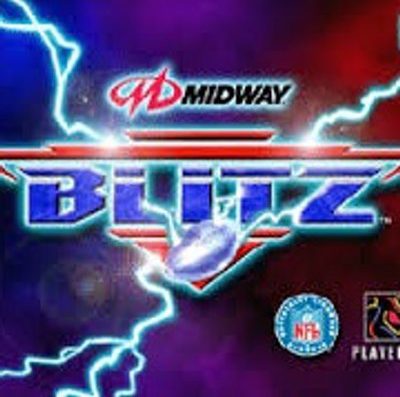A lot has been said about Teddy Bridgewater’s sophomore season of 2015.
After a nice rookie season where most people were sold on him as a young quarterback for the Minnesota Vikings, all the praise suddenly turned into hostility, when future HOF runningback Adrian Peterson returned and had an All-Pro year. Though the Vikings made the playoffs by winning the NFC North division at 11-5, Teddy was widely accused of being carried by Peterson throughout the season.
After looking at his stats, it’s easy to see why. In 16 games Teddy completed 292 of 447 passes for 3,231 yards, 14 TD and 9 INT, while 4 of his touchdowns came from a week 15 game against the Chicago Bears. In addition, fellow draft classmates Derek Carr and Blake Bortles threw for more touchdowns in 2015 than Teddy has in his entire career so far.
Now we come to the following question; Why has Teddy not produced as many touchdowns as Carr and Bortles? Is it because he’s too scared to throw? Is he too conservative with his passes? Is he holding the Vikings back?
After watching his entire sophomore season, I can say this; The Vikings, not Teddy, were holding him back. Certain quarterbacks have a reputation for being conservative because their skill sets are so limited that that’s the offense they’re part of. Teddy has a reputation for being conservative because his supporting cast is suffocating him.
Some have suggested that Peterson himself is holding Teddy back, but this, to me, is only from a fantasy standpoint. If you have a great running back like Peterson, it shouldn’t matter what your volume is, but rather what your offense asks you to do when it’s your turn to step up. Sadly, in 2015 Teddy didn’t have as many chances to show case his talents as some of the top quarterbacks in the league, and this was mainly because his offensive line could not protect him.

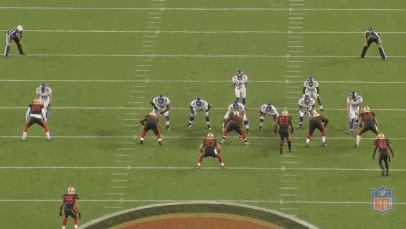

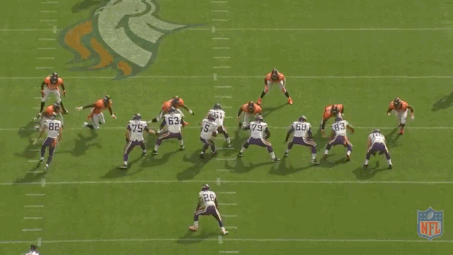


These are only several of the 44 sacks Teddy took in 2015 (the first one is from the Wild Card game against the Seahawks, so it does not count when applied to regular season stats), but they speak a lot about how bad Minnesota’s pass protection was. You may have noticed that a few of this GIFs have featured tackle Matt Kalil blowing protection. Kalil has been one of the worst linemen in the league for quite some time after a Pro Bowl year in his first season, and seeing him get beaten so easily is bad for the Vikings.
But more importantly, the pass protection doesn’t give Teddy time to survey to field, instead forcing him on the run because of how incompetent they have been as a whole. By the time a receiver is finally able to gain separation, it’s far too late, as Teddy usually has been grabbed or sacked when that happens.
Speaking of which, Teddy’s receivers are another problem holding him back. Stefon Diggs is a solid receiver, and Laquon Treadwell is a promising draft choice, but otherwise he doesn’t have any consistent options.




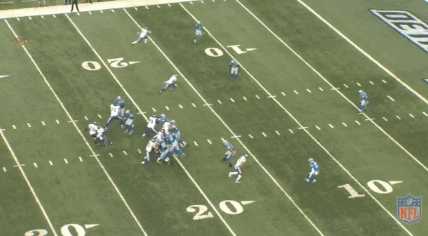




On these plays, Teddy is forced to throw the ball away due to pressure. The GIFs here are small considering the size of the playing field, but all that’s required is to take a look at Teddy’s receivers. None of them are gaining separation, and on a few instances, they’re open but not near the first down marker on 3rd down or near adequate yardage in the two-minute drill.
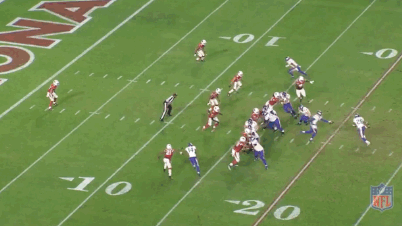










This is why Teddy’s stats aren’t near Carr’s or Bortles. Carr and Bortles have good stats not just because of their talent, but because their receivers are able to gain separation and not overwhelm the quarterback. Their situations are far better than the one Teddy is in. While I can’t say receivers didn’t get open on ALL of the throwaways, the moments where that was the case were anomalies.
And would you believe this isn’t even close to being all of the throwaways from 2015?
Whether this is on offensive coordinator Norv Turner for not creating better routes, the receivers for not getting separation, or both, there’s not much Teddy can do in these situations but throw the ball away. He’s had to live to with a reputation for preventing the Vikings from moving the chain, when in reality the Vikings are preventing him from moving the chain.
Teddy’s receivers on the whole weren’t very good in 2015, with the obvious exception of Diggs. For example Mike Wallace hasn’t been right for years, and was mostly a liability in his time. Jarius Wright is talked about highly in a few places, and while isn’t terrible, his skill set is average and he doesn’t create much separation. The receivers also dropped passes in critical situations that stalled drives.
As a result, Teddy wasn’t given as many chances to show off that he could make big plays as he would have liked.
If you’re on Teddy’s side of this argument, you’re probably wondering if there are moments where he isn’t being suffocated. Fortunately, the answer is yes. When Teddy wasn’t being devoured, he was busy throwing dimes. Despite his reputation, his football intelligence is vast. With the exception of 25+ yard plays, he is usually spot on in accuracy, and is able to place the ball in the right spot without forcing the receiver to lose potential yards after the catch.




On each of these four plays, Teddy has great awareness of what’s surrounding him, and sets his feet to make more suitable throws. The 2nd throw is especially great because the placement allows his receiver to adjust and make the grab without getting drilled by the defensive back covering him. The fourth is perhaps the best because of the touch on the run as his receiver is right at the sideline.
When the Vikings offensive line managed to do their job, we saw how Teddy looked with it. The results were pretty damn good.



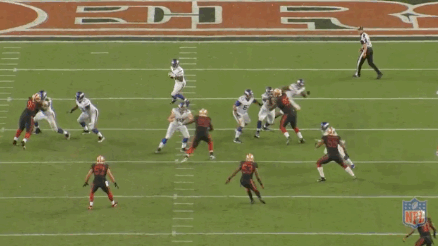
These are a taste of what #5 would look like if his offensive line consistently protected him. On all of these plays, Teddy uses the protection to his advantage, dancing around the pocket to fool the pressure, then moving out of it to deliver some dimes. He is a very mobile QB, and as such can trick out defenders and leave them in the dust on such situations.
Throughout his young career, Teddy has also been very good under pressure. He understands when the play is hopeless and when to throw the ball away, but he also succeeds in creating plays while under pressure.





On each of these plays, Teddy is under heavy pressure but makes a big play anyway. At first, the last play looks routine, but look closer and #5 is making the throw just before he’s hit. The run play against the Giants is a perfect example of him carrying the team by getting crucial first down yardage in a way only he can.
The Vikings are not a bad team. The run game is excellent with Adrian Peterson, backup Jerick McKinnon and (occasionally) Teddy, and the defense is one of the better units in the league. These 2 components were key in helping get the team to the playoffs last year (and while there, Teddy played a good debut against the Seahawks, staying accurate despite a late Peterson fumble, his protection and receivers failing him, and the infamous Blair Walsh shank.)
It’s the receivers and offensive line that are the big problem. With Peterson succeeding because he’s able to create lots of yardage on his own, many are quick to judge the quarterback’s playing style and ability to carry his team. It doesn’t help that his peers have better production in better situations. If the receivers and offensive line gave him more breathing room, Teddy’s production would be far better than it is right now.
You’ll see none of that judgment here. Teddy is a good quarterback that at his high point is really accurate, smart in picking out the open receiver, and precise with placement on plays requiring yards after the catch. I really enjoyed watching him at his best.
It’s on the Vikings to change things to that the quarterback isn’t forced to throw the ball away, take a sack, or live with his unearned reputation as a conservative game manager that limits opportunities for his team. Mike Zimmer is a good coach, has certainly helped turn the organization around by improving the defense dramatically, but that isn’t enough. Hopefully the addition of Treadwell to Diggs should make things a bit easier, which is the same for Western Michigan guard Willie Beavers.
The objective is simple; give Teddy space, and he’ll create plays, not erase them.
(Featured image via wsj.com)
